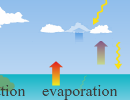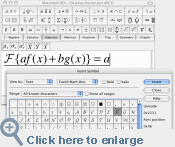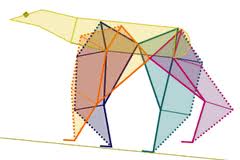Math learning need support so learning more interesting and meaningful. Therefore, teachers must prepare learning material as well. In order to create a good teaching material must be supported with math learning software, because of the inordinate use of mathematical symbols. Here I refer to mathematical software that can be downloaded.
1.
CalcuTray
CalcuTray is a simple, quick and easy to use calculator that resides in the system tray and enables you to quickly perform a mathematical calculation by simply typing in the numbers, using the standard mathematical operators (+, -, *, / etc.). In addition to basic calculations, CalcuTray also be used to solve square roots and convert fractions to decimals. You can also use Pi in any of your calculations.
2.
Kalkules
Kalkules is an universal
scientific freeware calculator with an amount of untraditional functions, which can be used particularly by high school or university students. It also offers a wide range of tools, which
make your calculations easier and faster.
3.
yoshinoCALC
yoshinoCALC is a free scientific calculator utilizing a dll to evaluate mathematical expressions.
4.
Vectoration
Simple and functional vector calculation program
5.
MagicCalc
MagicCalc is a full functions fullscreen graphic calculator
6.
sparseLM
sparseLM is a software package for efficiently solving arbitrarily sparse non-linear least squares problems. It offers a generic implementation of the Levenberg - Marquardt optimization algorithm on top of a variety of sparse direct solvers, thus being applicable to problems with arbitrary sparseness. sparseLM accepts sparse Jacobians encoded in either compressed row storage (CRS) or compressed column storage (CCS, aka Harwell-Boeing) format. It is also possible to supply it just with the Jacobian's sparsity pattern and have its values be numerically approximated using finite differences, or even instruct it to attempt the automatic detection of the sparsity pattern corresponding to the Jacobian of the function to be minimized. For dense non-linear least squares problems, project levmar is more appropriate.
7.
CM
CM is a C# based Mathematical language which makes it easier for scientist, engineers and students to do scientific computation. CM will provide a mechanism for “NO LOOP” programming which is much like MatLab or Fortran. It's developed in C#.
8.
Microsoft Mathematics
Microsoft Mathematics provides a set of mathematical tools that help students get school work done quickly and easily. With Microsoft Mathematics, students can learn to solve equations step-by-step while gaining a better understanding of fundamental concepts in pre-algebra, algebra, trigonometry,
physics, chemistry, and calculus.
9.
Simple Solver
Design and analysis of Boolean equations and state machines
10.
Maxima -- GPL CAS based on DOE-MACSYMA
Maxima is a fairly complete computer algebra system written in lisp with an emphasis on symbolic computation. It is based on DOE-MACSYMA and licensed under the GPL. Its abilities include symbolic integration, 3D plotting, and an ODE solver
11.
Eukleides
Eukleides is a computer language devoted to elementary plane geometry. It aims to be a fairly comprehensive system to create geometric figures, either static or dynamic. It can handle geometric types of data like points, vectors, lines, circles, or conics. A Eukleides script usually consists of a declarative part where objects are defined and a descriptive part where objects are drawn. Nonetheless, Eukleides is also a full featured programming language, providing conditional and iterative
structures, user defined functions, modules, etc. The Eukleides distribution provides two distinct interpreters: "eukleides" and "euktopst". The former interpreter produces Encapsulated PostScript (EPS). The latter produces PSTricks macros, allowing Eukleides to be used with LaTeX.
12.
GlassCalc
GlassCalc is a simple calculator with extensive support for mathematical expressions.
13.
7math
7math is a program designed to solve equations.
14.
RedCrab
RedCrab is a scientific calculator with a full-screen editor. The mathematical expressions are not typed in a typical command line, but can be enter in the editor window.
15.
Functy
Functy is a 3D graph drawing package. The emphasis of
the application is to allow Cartesian and spherical functions to be plotted and altered quickly and easily. This immediacy and the vivid results are intended to promote fun exploration of 3D functions.
16.
MathCast
MathCast is an equation editor, an application that allows you to input mathematical equations. These equations can be used in written documents, webpages, and even databases. They could be rendered graphically to the screen, to picture files, or to MathML - today’s leading standard language for describing mathematics.
17.
FriCAS
FriCAS is an advanced computer algebra system. Its capabilities range from calculus (integration and differentiation) to abstract algebra. It can plot functions and ha san integrated help system. It is a fork of the wh-sandbox branch of the Axiom project.
18.
eCalc
A free Windows calculator with basic and scientific functions.
19.
gsrpn
gsrpn is a very usable HP-like RPN pocket calculator. It is based on JavaScript and works with any modern Web browser. It's fast and handy thanks to its keyboard interface.
20.
Antiprism
Antiprism is a set of programs for generating, manipulating, transforming, and viewing models of polyhedra.
21.
SpeQ
SpeQ is a small, extensive mathematics program with a simple, intuitive interface.
22.
Mathomatic
• Mathomatic is a portable, general purpose CAS (Computer Algebra System) that can symbolically solve, simplify, combine, and compare algebraic equations, perform complex number and polynomial arithmetic, etc. It does some calculus and is very easy to use
23.
Calcoo
Calcoo is a scientific calculator designed to provide maximum usability. Its features bitmapped button labels and
display digits to improve readability, no double-function buttons, undo/redo buttons, copy/paste interaction with the clipboard, both RPN and algebraic modes, two memory registers with
displays, displays for Y, Z, and T registers, and tick marks to separate thousands.
24.
Freemat
Freemat is an intepereted, matrix-oriented development environment for engineering and scientific applications, similar to the commercial package MATLAB. It provides visualization, image manipulation, and plotting as well as parallel programming.
25.
Easy Funktion
Easy Funktion is 2D function plotter software with an equation solver. It has an office-like GUI frontend and features a built-in pocket calculator, calculating with complex numbers (with special extensions for electronics, e.g. capacitor/inductor impedance), a function to export to spreadsheet software, and an advanced formula editor with automatic formatting.
26.
ABA-X1
An application that calculates mathematical expressions.
27.
Math Ninja
Math Ninja is an educational math game that can help you practice your math skills. It offers 8 levels of difficulty that include Addition, Subtraction, Multiplication and Division with an option to....
28.
ESBCalc
Handy Freeware Scientific Calculator with many features.
29.
Trical
TriCal is a formula, expression and conversion calculator.
30.
KidsMath
Cool easy to use calculator that stays on top all the time.
31.
TuxMathScrabble
TuxMathScrabble challenges young people to construct compound equations and consider multiple abstract possibilities. There are four skill levels for practice, from basic addition and subtraction through multiplication and division. This software includes a data recorder interface for student performance assessment. The data is recorded in the same format as data from other applications built upon the EduApp framework (also by Asymptopia Software). This enables
comparison of common variables across multiple applications for formative learning assessment.
32.
Equation Grapher
Use this program to graph 2D equations.
33.
Gauss
Displays lines and surfaces defined algebraically in 3D space in many forms.
34.
tabbyCalc
A minimalist windows desktop calculator and mathimatical expression evaluator.
35.
Jmath
Jmath is a Computer Algebra System(CAS) targeted at high school students.
36.
Moffsoft FreeCalc
Moffsoft FreeCalc is a basic calculator that offers a virtual tape display, that keeps track of your calculations, and can be printed, copied or saved to a
text file. Additional features include visi....
37.
JCalculator
Evaluate mathematical expressions.
38.
Falling Formulas
A mathematical tetris clone - Form equations to get the blocks to disappear.
39.
Multiplication Facts
Learn and practice the basic times tables using the numbers zero through twelve.
40.
Sicyon
All-in-one calculator boasting 50 features.
41.
ESBCalc
Handy Freeware Scientific Calculator with many features.
42.
Envisage
Visualize and analyze various types of mathematical functions and data.
43.
Multiplication Station
Multiplication Station will teach your child to add, subtract, and multiply. It is a multi-user application with a simple admin interface. All parameters are configurable, like grid size and the fonts and colors of number ranges. A countdown timer is used to keep the player's attention focused. A list of high scores is maintained.
44.
SkinCalc
Calculator with more than 100 skins.
45.
Mathemagic
Teach your 2nd, 3rd or 4th grader math with exciting and fun exercises.
46.
Spotter
Spotter is software that can check students' answers to symbolic and numerical problems in math and science. It recognizes an answer regardless of the form it's in, and the instructor can put in helpful hints as responses to frequently-occurring mistakes. Symbolic answers can be input in a notation closely resembling normal human math notation (e.g., xy rather than x*y, and sin x instead of sin(x)). Spotter runs as a Perl CGI application on a Web server; the student doesn't need to install any software.
47.
HorsePower
HorsePower is J2ME scientific calculator optimised for use on mobile phones, with the appearance of the classic range of Hewlett Packard calculators (MIDP 1.0 and CLDC 1.0).
48.
Analytic Math
Free math / graphing program - an excellent tool for function visualization.









































